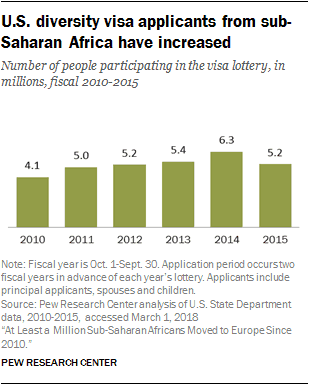At Least a Million Sub-Saharan Africans Moved to Europe Since 2010
Phillip Connor, Pew Research Center, March 22, 2018
{snip}
The factors pushing people to leave sub-Saharan Africa – and the paths they take to arrive at their destinations – vary from country to country and individual to individual. In the case of Europe, the population of sub-Saharan migrants has been boosted by the influx of nearly 1 million asylum applicants (970,000) between 2010 and 2017, according to a Pew Research Center analysis of data from Eurostat, Europe’s statistical agency. Sub-Saharan Africans also moved to European Union countries, Norway and Switzerland as international students and resettled refugees, through family reunification and by other means.3
In the U.S., those fleeing conflict also make up a portion of the more than 400,000 sub-Saharan migrants who moved to the States between 2010 and 2016. According to data from U.S. Department of Homeland Security and U.S. State Department, 110,000 individuals from sub-Saharan countries were resettled as refugees over this seven-year period. An additional 190,000 were granted lawful permanent residence by virtue of family ties; nearly 110,000 more entered the U.S. through the diversity visa program.4
{snip} According to a 2017 Pew Research Center survey in six sub-Saharan countries that have supplied many of the region’s migrants to the U.S. and Europe, many say they would move to another country if the means and opportunity presented themselves. And in Senegal, Ghana and Nigeria, more than a third say they actually plan to migrate in the next five years. Of those who plan to move, more individuals plan to move to the U.S. than to Europe in most countries surveyed.
{snip}
EU countries, Norway and Switzerland received nearly 1 million first-time asylum applications from sub-Saharan Africans between 2010 and 2017, according to data from Eurostat, Europe’s statistical agency. (This number removes application counts withdrawn by sub-Saharan Africans between 2010 and 2017 to account for the possible duplication of asylum seekers applying in multiple countries). But asylum applications are not the only way sub-Saharan migrants enter Europe. Some enter, for example, on family or work visas, or as resettled refugees or international students, so the total inflow is likely larger.
At the same time, U.S. Department of Homeland Security and U.S. State Department records indicate that more than 400,000 sub-Saharan Africans entered the U.S. between fiscal 2010 and fiscal 2016 as arriving lawful permanent residents or resettled refugees. (Data from fiscal 2017 were unavailable). A smaller number of sub-Saharan Africans also entered the U.S. as international students or as employees with work visas.
(51%) of sub-Saharan African migrants living in the U.S. as of 2017 were born in just four countries: Nigeria, Ethiopia, Ghana and Kenya, according to migrant population data from the United Nations.5
{snip}
In the U.S., between 2010 and 2017, several sub-Saharan migrant populations increased, including those from Nigeria (70,000 individuals), Ethiopia (70,000) and Ghana (40,000).
In terms of destinations, as of 2017, nearly three-quarters (72%) of Europe’s sub-Saharan immigrant population was concentrated in just four countries: the UK (1.27 million), France (980,000), Italy (370,000) and Portugal (360,000). In the U.S., migrants from sub-Saharan Africa can be found across the country, with 42% in the American South, 24% in the Northeast, 18% in the Midwest and 17% in the West.6
Between February and April 2017, Pew Research Center surveyed in six of the 10 countries that have supplied many of the sub-Saharan immigrants now living in the U.S. Four of these countries – Nigeria, Senegal, Ghana and Kenya – are also among the top 10 origin countries for sub-Saharan migrants to Europe.
The survey asked respondents whether they would go to live in another country, if they had the means and opportunity. At least four-in-ten in each sub-Saharan country surveyed answered yes, including roughly three-quarters of those surveyed in Ghana (75%) and Nigeria (74%).
{snip}
Will all those with plans to migrate in fact leave their home countries in the next five years? If recent history is a guide, the answer would most likely be no. But data from official sources suggest that this will not be for lack of effort.
For example, 1.7 million Ghanaians (or 6% of Ghana’s population) applied for the U.S. diversity lottery in 2015, even when only 50,000 people worldwide are permitted to move each year to the U.S. through this visa program. In the same year, other sub-Saharan African countries, such as the Republic of Congo (10%), Liberia (8%) and Sierra Leone (8%) saw high shares of their populations apply for the lottery. Although the lottery only requires an online application and the completion of a high school diploma for eligibility, the high number of applicants underscores the seriousness with which many sub-Saharan Africans contemplate and actively pursue migrating abroad.
Europe’s border statistics show a well-traveled route of migrants from Africa to Europe. But this does not necessarily mean Europe is the top choice of potential sub-Saharan African migrants. In fact, in several of the countries surveyed by Pew Research Center, those planning to migrate more often cited the U.S., as opposed to Europe, as their preferred destination when asked where in the world they planned to move.
{snip}
Only in Senegal, a Francophone country, do more respondents that plan to move intend to migrate to a European country (49%), as opposed to the United States (24%).
{snip}
[Editor’s Note: Several other charts accompany the original story.]
















